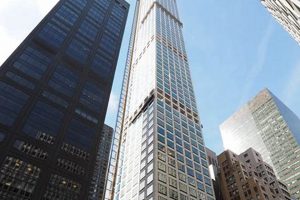Skyscrapers are defined as buildings with more than 40 stories. They are typically constructed in urban areas where land is scarce and expensive. The height of a skyscraper is determined by a number of factors, including the building’s intended use, the availability of land, and the local building codes.
The first skyscraper was the Home Insurance Building in Chicago, which was completed in 1885 and stood 10 stories tall. Over the years, skyscrapers have become increasingly taller, with the current tallest building being the Burj Khalifa in Dubai, which stands 163 stories tall.
There are a number of benefits to building skyscrapers. They can accommodate a large number of people in a relatively small area, which can help to reduce traffic congestion and pollution. Skyscrapers can also be designed to be energy-efficient, which can help to reduce operating costs.
1. Height
The height of a skyscraper is one of its most important features. It is a major factor in determining the building’s overall cost, design, and functionality. The height of a skyscraper is also a major factor in its impact on the surrounding environment.
There are a number of reasons why height is important in skyscraper design. First, the height of a skyscraper can be used to create a more efficient use of space. By building up, rather than out, skyscrapers can accommodate more people and businesses in a smaller area. This can be especially important in densely populated urban areas where land is scarce.
Second, the height of a skyscraper can be used to create a more iconic and recognizable building. A tall skyscraper can be a landmark for a city or region, and can help to create a sense of place. For example, the Empire State Building is one of the most recognizable buildings in the world, and is closely associated with New York City.
Third, the height of a skyscraper can be used to create a more sustainable building. Tall skyscrapers can be designed to be more energy-efficient than shorter buildings. For example, tall skyscrapers can be designed to take advantage of natural ventilation and daylighting, which can reduce the need for artificial lighting and heating.
Of course, there are also some challenges associated with building tall skyscrapers. One challenge is that the taller a building is, the more difficult it is to construct and maintain. Another challenge is that the taller a building is, the more wind it will experience. This can make it difficult to design a skyscraper that is both tall and safe.
Despite these challenges, the height of a skyscraper remains an important factor in its design and functionality. By carefully considering the height of a skyscraper, architects and engineers can create buildings that are both efficient and iconic.
2. Floors
There is a direct relationship between the number of floors in a skyscraper and its height. The more floors a skyscraper has, the taller it will be. This is because each floor adds to the building’s overall height. For example, a skyscraper with 100 floors will be taller than a skyscraper with 50 floors.
The number of floors in a skyscraper is also important for determining its overall design and functionality. For example, a skyscraper with a large number of floors will need to have a strong foundation and structural system to support its weight. The building will also need to have efficient elevators and other transportation systems to move people and goods between floors.
The number of floors in a skyscraper can also affect its energy efficiency. For example, a skyscraper with a large number of floors will have a larger surface area, which can lead to increased heat loss. This can make it more difficult to heat and cool the building, which can lead to higher energy costs.
Overall, the number of floors in a skyscraper is an important factor that affects its height, design, functionality, and energy efficiency. By carefully considering the number of floors in a skyscraper, architects and engineers can create buildings that are both efficient and iconic.
3. Area
The area of a skyscraper is the total amount of space that it occupies on the ground. This includes the area of the building’s footprint, as well as the area of any setbacks or other open spaces around the building.
- Building Footprint
The building footprint is the area of the building that is in contact with the ground. This includes the area of the building’s foundation, as well as the area of any below-grade spaces, such as basements or parking garages.
- Setbacks
Setbacks are areas of open space that are required around tall buildings in many cities. Setbacks help to ensure that buildings do not block sunlight from neighboring buildings and streets. They also help to create a more visually appealing streetscape.
- Other Open Spaces
In addition to setbacks, other open spaces around a skyscraper can include plazas, courtyards, and gardens. These open spaces can provide a variety of benefits, such as recreation, relaxation, and stormwater management.
The area of a skyscraper is an important factor in determining its height. This is because the taller a building is, the more area it will need to occupy on the ground. For example, a skyscraper with a large footprint will be able to support more floors than a skyscraper with a small footprint.
The area of a skyscraper can also affect its design and functionality. For example, a skyscraper with a large footprint will be able to accommodate more tenants and amenities than a skyscraper with a small footprint. The area of a skyscraper can also affect its energy efficiency. For example, a skyscraper with a large footprint will have a larger surface area, which can lead to increased heat loss. This can make it more difficult to heat and cool the building, which can lead to higher energy costs.
Overall, the area of a skyscraper is an important factor that affects its height, design, functionality, and energy efficiency. By carefully considering the area of a skyscraper, architects and engineers can create buildings that are both efficient and iconic.
4. Purpose
The purpose of a skyscraper is a major factor in determining its height. Skyscrapers are built for a variety of purposes, including:
- Residential: Residential skyscrapers are designed for people to live in. They typically have apartments or cond
ominiums on multiple floors. - Commercial: Commercial skyscrapers are designed for businesses to operate in. They typically have offices on multiple floors.
- Mixed-use: Mixed-use skyscrapers combine residential and commercial uses. They typically have a mix of apartments, condominiums, and offices on multiple floors.
The purpose of a skyscraper can also affect its design and functionality. For example, residential skyscrapers typically have more amenities than commercial skyscrapers, such as swimming pools, fitness centers, and doormen. Commercial skyscrapers, on the other hand, typically have more efficient floor plans and more advanced security systems.
The purpose of a skyscraper can also affect its height. For example, residential skyscrapers are typically taller than commercial skyscrapers because they need to accommodate more people. Mixed-use skyscrapers are typically the tallest type of skyscraper because they combine the needs of both residential and commercial users.
Overall, the purpose of a skyscraper is an important factor in determining its height, design, and functionality. By carefully considering the purpose of a skyscraper, architects and engineers can create buildings that are both efficient and iconic.
5. Location
The location of a skyscraper is a major factor in determining its height. There are a number of reasons for this, including:
- Building codes: Building codes are regulations that govern the construction of buildings. These codes vary from city to city, and they can have a significant impact on the height of skyscrapers. For example, some cities have height limits that restrict the height of buildings. Other cities have more lenient height limits, which allow for the construction of taller skyscrapers.
- Land availability: The availability of land is another important factor that affects the height of skyscrapers. In densely populated urban areas, land is scarce and expensive. This can make it difficult to find a suitable site for a tall skyscraper. In less densely populated areas, land is more plentiful and less expensive, which can make it easier to find a site for a tall skyscraper.
- Geology: The geology of a site can also affect the height of a skyscraper. For example, skyscrapers built on soft soil are more likely to sink or settle over time. This can make it difficult to build a tall skyscraper on soft soil. Skyscrapers built on rock are less likely to sink or settle, which makes it easier to build taller skyscrapers on rock.
In addition to these factors, the location of a skyscraper can also affect its design and functionality. For example, skyscrapers built in earthquake-prone areas are typically designed with special features to resist earthquakes. Skyscrapers built in hurricane-prone areas are typically designed with special features to resist hurricanes.
Overall, the location of a skyscraper is an important factor that affects its height, design, and functionality. By carefully considering the location of a skyscraper, architects and engineers can create buildings that are both safe and efficient.
6. Materials
The materials used to construct a skyscraper have a major impact on its height. This is because the materials used must be strong enough to support the weight of the building and withstand the forces of wind and gravity. The materials used must also be able to resist fire and other hazards.
- Steel
Steel is one of the most common materials used to construct skyscrapers. Steel is strong and lightweight, and it can be easily shaped into a variety of forms. Steel is also relatively fire-resistant, which makes it a good choice for high-rise buildings.
- Concrete
Concrete is another common material used to construct skyscrapers. Concrete is strong and durable, and it can be poured into complex shapes. Concrete is also relatively fire-resistant, which makes it a good choice for high-rise buildings.
- Glass
Glass is a relatively new material that is being used to construct skyscrapers. Glass is strong and lightweight, and it can be used to create a variety of architectural effects. Glass is not as fire-resistant as steel or concrete, but it can be treated with fire-resistant coatings to improve its performance.
- Composite materials
Composite materials are made from a combination of two or more materials. Composite materials are often stronger and lighter than traditional materials, and they can be tailored to meet specific performance requirements. Composite materials are becoming increasingly popular for use in the construction of skyscrapers.
The choice of materials used to construct a skyscraper is a complex one. Architects and engineers must consider a variety of factors, including the height of the building, the wind and gravity loads that it will be subjected to, and the fire safety requirements. By carefully selecting the right materials, architects and engineers can create skyscrapers that are both safe and efficient.
7. Design
The design of a skyscraper is a complex process that involves a number of factors, including the building’s height, function, and location. The design of a skyscraper must also take into account the forces of wind and gravity, as well as the need for fire safety and other safety considerations.
The height of a skyscraper is one of the most important factors that affects its design. The taller a skyscraper is, the more wind and gravity loads it will be subjected to. This means that the building must be designed with a strong foundation and structural system to support its weight and withstand the forces of wind and gravity.
The function of a skyscraper also affects its design. For example, a residential skyscraper will have different design requirements than a commercial skyscraper. Residential skyscrapers typically have more amenities, such as swimming pools, fitness centers, and doormen. Commercial skyscrapers, on the other hand, typically have more efficient floor plans and more advanced security systems.
The location of a skyscraper also affects its design. For example, skyscrapers built in earthquake-prone areas are typically designed with special features to resist earthquakes. Skyscrapers built in hurricane-prone areas are typically designed with special features to resist hurricanes.
The design of a skyscraper is a complex process that requires careful consideration of a number of factors. By carefully considering all of these factors, architects and engineers can create skyscrapers that are both safe and efficient.
8. Construction
The construction of a skyscraper is a complex and challenging process that requires careful planning and execution. The height of a skyscraper is one of the most important factors that affects its construction. The taller a skyscraper is
, the more difficult it is to construct and the more expensive it will be. There are a number of factors that must be considered during the construction of a skyscraper, including the building’s foundation, structural system, and exterior cladding.
The foundation of a skyscraper is one of the most important aspects of its construction. The foundation must be strong enough to support the weight of the building and withstand the forces of wind and gravity. The foundation is typically made of concrete and steel, and it is often reinforced with piles that are driven deep into the ground. The structural system of a skyscraper is also critical to its safety and stability. The structural system is made up of the building’s frame, which is typically made of steel or concrete. The frame is designed to transfer the weight of the building to the foundation and to resist the forces of wind and gravity.
The exterior cladding of a skyscraper is also important for its safety and appearance. The exterior cladding is made up of the building’s windows, doors, and walls. The exterior cladding must be able to withstand the elements and protect the building from fire. The exterior cladding is also an important part of the building’s overall design.
The construction of a skyscraper is a complex and challenging process, but it is also a rewarding one. Skyscrapers are some of the most iconic structures in the world, and they play a vital role in the economy and culture of cities. By understanding the construction process, we can appreciate the skill and ingenuity of the engineers and architects who design and build these amazing structures.
FAQs about “how high are skyscrapers”
Skyscrapers are one of the most iconic structures in the world. They are a symbol of power, wealth, and ambition. But how high are skyscrapers? And what are the factors that determine their height?
Question 1: What is the tallest skyscraper in the world?
Answer: The tallest skyscraper in the world is the Burj Khalifa in Dubai, United Arab Emirates. It is 828 meters (2,717 feet) tall.
Question 2: What is the average height of a skyscraper?
Answer: The average height of a skyscraper is between 150 and 300 meters (492 and 984 feet). However, there are many skyscrapers that are taller or shorter than this range.
Question 3: What are the factors that determine the height of a skyscraper?
Answer: The height of a skyscraper is determined by a number of factors, including the building’s intended use, the availability of land, and the local building codes.
Question 4: What are the benefits of building tall skyscrapers?
Answer: There are a number of benefits to building tall skyscrapers. They can accommodate a large number of people in a relatively small area, which can help to reduce traffic congestion and pollution. Skyscrapers can also be designed to be energy-efficient, which can help to reduce operating costs.
Question 5: What are the challenges of building tall skyscrapers?
Answer: There are a number of challenges to building tall skyscrapers. One challenge is that the taller a building is, the more difficult it is to construct and maintain. Another challenge is that the taller a building is, the more wind it will experience. This can make it difficult to design a skyscraper that is both tall and safe.
Question 6: What is the future of skyscraper construction?
Answer: The future of skyscraper construction is bright. There are a number of new technologies that are being developed that will make it possible to build taller and more sustainable skyscrapers in the future.
Summary: Skyscrapers are an important part of the modern world. They are a symbol of power, wealth, and ambition. The height of a skyscraper is determined by a number of factors, including the building’s intended use, the availability of land, and the local building codes. There are a number of benefits to building tall skyscrapers. They can accommodate a large number of people in a relatively small area, which can help to reduce traffic congestion and pollution. Skyscrapers can also be designed to be energy-efficient, which can help to reduce operating costs. However, there are also a number of challenges to building tall skyscrapers. One challenge is that the taller a building is, the more difficult it is to construct and maintain. Another challenge is that the taller a building is, the more wind it will experience. This can make it difficult to design a skyscraper that is both tall and safe.
Transition: The construction of skyscrapers is a complex and challenging process. However, it is also a rewarding one. Skyscrapers are some of the most iconic structures in the world, and they play a vital role in the economy and culture of cities.
Tips for designing tall skyscrapers
Skyscrapers are an important part of the modern world. They are a symbol of power, wealth, and ambition. However, designing and constructing tall skyscrapers is a complex and challenging process. Here are a few tips to help you design tall skyscrapers that are both safe and efficient:
Tip 1: Consider the building’s intended use
The first step in designing a tall skyscraper is to consider the building’s intended use. This will help you determine the building’s height, floor plan, and other design features. For example, a residential skyscraper will have different design requirements than a commercial skyscraper.
Tip 2: Choose the right materials
The materials you use to construct your skyscraper will have a major impact on its height and safety. Steel and concrete are the most common materials used to construct skyscrapers. Steel is strong and lightweight, while concrete is strong and durable. You may also want to consider using composite materials, which are made from a combination of two or more materials.
Tip 3: Design a strong foundation
The foundation of your skyscraper is one of the most important aspects of its design. The foundation must be strong enough to support the weight of the building and withstand the forces of wind and gravity. The foundation is typically made of concrete and steel, and it is often reinforced with piles that are driven deep into the ground.
Tip 4: Use a strong structural system
The structural system of your skyscraper is also critical to its safety and stability. The structural system is made up of the building’s frame, which is typically made of steel or concrete. The frame is designed to transfer the weight of the building to the foundation and to resist the forces of wind and gravity.
Tip 5: Consider the building’s energy efficiency
Skyscrapers can be energy-efficient buildings. By using energy-efficient materials and systems, you can reduce the building’s operating costs and environmental impact.
Summary: By following these tips, you can design tall skyscrapers that are both safe and efficient. Skyscrapers are an important part of the modern world, and they can play a vital role in the economy and culture of cities.
Transition: The construction of skyscrapers is a complex and challenging process. However, it is also a rewarding one. Skyscrapers are some of the most iconic structures in the world, and they can inspire us to reach new heights.
Conclusion
Skyscrapers are one of the most iconic structures in the world. They are a symbol of power, wealth, and ambition. The height of a skyscraper is determined by a number of factors, including the building’s intended use, the avai
lability of land, and the local building codes. There are a number of benefits to building tall skyscrapers. They can accommodate a large number of people in a relatively small area, which can help to reduce traffic congestion and pollution. Skyscrapers can also be designed to be energy-efficient, which can help to reduce operating costs.
Skyscrapers are an important part of the modern world. They play a vital role in the economy and culture of cities. As technology continues to advance, we can expect to see even taller and more innovative skyscrapers in the future.







